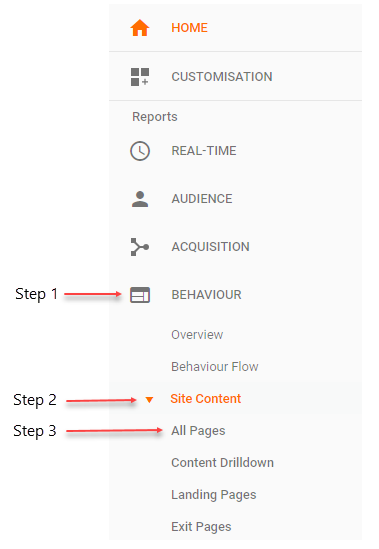
Want more traffic to your website? Business blogging is an ideal way to increase web traffic as well as improve online visibility, raise brand awareness and drive business growth.
In fact, business blogging, when done well, is an effective way to create opportunities to get your website found by the right people, so you can generate new leads and customers for your business. Utilising SEO services to build content for search engines allows your website to bring in long-term qualified traffic.
So how does creating a business blog increase the chances of your website being found by people searching for your products and services?
It’s simple. By publishing blog articles about topics related to your industry, you are increasing the chance that Google will index your site or provide it as a search result for potential customers looking for your products or services.
Google’s main purpose is to answer the questions users ask, therefore to appear in the search results, the content on your website needs to answer the questions that your customers are asking.
You may be surprised to learn that 70% of web users prefer to learn about a business and its products or services through articles, rather than ads. This is the basis of content marketing.
A further 60% of web users are inspired to seek out a product or service after reading content about it.
Business blogging is a cost-effective form of content marketing that can drive traffic, help increase sales, save marketing budget and build brand loyalty.
Creating a blog
So how do you create a business blog?
This depends on which CMS (Content Management System) your website uses. If you are unsure, it’s best to contact your web developer, as it’s important to get your blog set up correctly.
Your blog posts should live in a dedicated folder on your website (most CMS allow you to dynamically set up a blog this way). This means that the web address of your blog will look like this:
www.yourwebsite.com.au/blog/
and the web address of your blog posts should look something like this (depending on what you name your blog post):
www.yourwebsite.com.au/blog/my-first-blog-post/
Once your blog structure is set up you’re ready to begin.
WCR Pro Tip: Ensure your blog lives in a dedicated folder on your website.
Know your readers
Before sitting down to write your first article, establish who your readers are. Ideally, you should produce content of interest to your ideal customers. So identifying who they are, what their pain points are and how your products/services can help solve these issues is fundamental.
A great way to identify your ideal customers and their interests are to create buyer personas (also known as customer profiles). Buyer personas take generalised characteristics of your real customers and assign them to fictional characters.
When creating buyer personas, it is important to identify both the demographic and behavioural traits of your customers.
Demographic traits such as location, age and gender are important for determining who your customers are and where they reside.
Behavioural traits signify their habits, goals and fears. This information helps identify your customers’ problems or ‘pain points’. In the context of blog content, this information can help guide the sorts of topics you cover on your blog and help you determine how your products and services can help solve your customers’ biggest problems.
Every article you write should provide useful and actionable information that will help the reader either solve a problem in their life or reach a goal.
WCR Pro Tip: Determine who you want to target before you write. Buyer personas summarise who your target customers are and how your products and services can help solve their problems, use this as inspiration for topics on your blog.
Find a unique topic or angle
There is no magic formula when it comes to creating a successful blog post, but there are a few steps you can follow to ensure you get the most out of each blog you write.
The first step is to find a topic. Use your buyer personas to brainstorm a topic that your customers may find interesting and most importantly, helpful. For example, if you’re an electrician, you might write a blog about how to change a light globe.
It should be a topic your customers are likely to search online and also relates to your products or services. Writing an article that solves a problem will position you as an authority in your industry and will help signify that your product is an invaluable resource.
If you are struggling with topic ideas, there are several free and paid tools available to help.
Take the time to research and evaluable whether a topic is worth writing about before you begin rather than creating a blog post that no one will find or read.
Answer the Public is a free website that uses autosuggest data from search engines. ‘Auto suggests’ are the search terms that appear when you begin typing a phrase in a search engine’s search bar.

By using tools such as Answer the Public you can uncover content ideas based on what your customers are searching for as well as discover the intent behind their search.
The intent behind a search is just as important as its popularity. In the example above, consider the intent of people searching ‘interior design trends’ and ‘interior design awards’.
Those searching for ‘interior design trends’ are most likely either considering redesigning a space of their own and researching Google trends or researching the industry. This presents an opportunity for an interior designer to write a blog about the topic and position their business as a thought leader and authority in the interior design industry.
In comparison, people searching for ‘interior design awards’ are most likely in the interior design industry and may even be a competitor. Writing an article based on this search intent wouldn’t resonate with your customers or capture your target audience.
When using tools such as Answer the People to brainstorm article ideas, use the suggestions as a guide. When writing your article, put an original spin on it, don’t just copy what has already been published.
As an expert in your field, you have an abundance of knowledge about your industry. Use this knowledge to find a unique perspective or angle on a popular topic.
Using the example above, instead of writing an article that lists current design trends, apply your knowledge to a niche industry such as the residential sector. You could write about current design trends for living rooms or kitchens.
This gives your article a specific focus and enables you to target readers who making more detailed searches. It also enables you to go into more detail about the subject providing in-depth value to your readers.
WCR Pro Tip: Use your industry knowledge to write about niche topics in your industry rather than broad topics that many will write about. Being specific enables you to provide in-depth value to your readers and positions you as an authority in your industry.
Focus on keywords
Keywords are ideas or topics that inform search engines of what your blog article is about.
Keywords in your article should be relevant to what people are searching for so they have a better chance of finding your content among search results.
Using the right keywords is important because keywords link what people are searching for to the content you are providing to fill that need.
Before writing your blog article, determine which keywords phrases related to your topic are likely to bring traffic.
There are many free tools you can use to find keywords and their popularity.
Paid tools such as ahrefs keyword explorer will provide additional information in addition to how many people are searching for your chosen keyword every month.
It will also tell you how difficult it will be for your article to rank in the top 10 for your chosen keyword and suggest ideas of alternative keywords that may be easier to rank for.
WCR Pro Tip: Do keyword research before writing your blog article. To increase traffic, look for keywords with low competition and high search volume.
Optimise your article
You’ve chosen your topics and keywords, it’s time to start writing. When writing, keep paragraphs short, no more than one or two sentences so they are easy to read and display well on mobile.
More than 55 per cent of people will only spend 15 seconds or less reading a blog. To make sure you capture and maintain readers attention, follow the inverted pyramid writing style that ensures the most relevant and important information is at the beginning of your article and supporting information follows.
It is also important to pick a web-safe font for your articles to ensure they will display clearly on both desktop and mobile websites.
Your blog article should be at least 600 words although articles of more than 1000 words tend to rank higher. The average word count of top-ranked search results is 2416 words, but don’t write more for the sake of it. The quality of the information you provide and its ability to solve readers’ problems is more valuable than the quantity.
When writing, remember to include your keywords naturally throughout the article, this will ensure that the search engines can clearly define what your article is about. Don’t include keywords in random sentences or where they wouldn’t make sense, this is referred to as keyword stuffing.
Your article should also include a call to action (CTA) at the end. This CTA should prompt readers to do something else on your site after reading your article.
If you article is informative and relates to your how your products and services can solve the readers problem, then prompting customers to read more about your products or services is a natural CTA you can make. However, this is what’s known as a soft call to action.
A hard call to action is one that filters the reader directly into your sales funnel by getting them to make a purchase, contact you directly or give you their contact information. Examples of hard call to actions include exclusive offers or access to free additional resources such as an eBook or guide when they enter their contact details. Whatever your CTA, make sure it relates to the topic of the article.
There are free and paid tools available to help with editing and making sure your article is SEO friendly.
Hemmingway is an app that helps determine improvements you can make to the language and grammar of your article to make it easier to read. The online version is free to use however the desktop version is paid.
SEMrush recently released an SEO Writing Assistant that evaluates the SEO friendliness of your writing and gives you an overall score out of 10. The tool is a Google Docs extension and can evaluate your use of keywords, suggest related keywords to include and suggest a word limit for your article.
You need a SEMrush account to use the SEO Writing Assistant which is paid. If paid tools aren’t an option for your business, try taking a break before editing your blog articles. A pair of fresh eyes can help pick up mistakes and opportunities to optimise your article that you might have missed.
Before publishing your article, write some metadata or meta tags.
Meta tags are snippets of text that describe a page’s content; the meta tags don’t appear on the page itself, but only in the page’s code (usually located in the html ‘head’ section).
Pay attention to the title and meta description tags. Meta title tags help search engines understand what your page is about and are the first impression many people have of your page.
The meta description tag provides a brief summary of a web page. Search engines often display the meta description—typically up to 160 characters long—in search results where they can highly influence user click-through rates.
SERP Simulator’s Google SERP Snippet Optimization Tool is a free tool that shows you what your metadata is likely to look like on a search engine results page.
WCR Pro Tip: Use this SEO blog writing checklist:
- Keep your paragraphs short
- Use the inverted pyramid writing style
- Pick a web-safe font
- Write at least 600 words
- Include a call to action (CTA)
- Edit and assess the grammar and SEO friendliness of your writing
- Optimise the metadata for the page your article will be hosted on
Amplify your blog
Optimising your blog using the tips outlined above will help increase your chances of building organic traffic to your blog.
However, don’t rely exclusively on organic traffic from search engines to attract readers to your blog. Sharing or amplifying your article can also boost the impact of your content.
Amplification is the process of ensuring your blog article is seen by as many people as possible..
Sharing a link to your blog article on your social media accounts is a form of content amplification. Here’s a list of methods for promoting your content.
WCR Pro Tip: Amplifying your article is the practice of ensuring it reaches as many people as possible. Do this by sharing on social media, promoting it via paid social media advertising and sharing it with industry influencers.
Track your traffic
The best way to evaluate and improve your content marketing is to track the impact of your blog posts on traffic to your website. Use Google Analytics to measure your analytics.
Read Google’s helpful resource to set up Google Analytics and find your way around the measurement tool.
In GA, to view the traffic your blog posts bring to your website log in to the platform and go to Behaviour > Site Content > All Pages

In the top right-hand corner, you will be able to change the date range. This controls what data is shown and gives you the option to compare that data to another period The date range you set will depend on what data you want to see and how often you post on your blog.

If your blog is in a dedicated folder it will appear as follows:
www.yourwebsite.com/blog/your-blog-post/
If your blog is hosted on a subdomain it will appear like this:
blog.yourwebsite.com/your-blog-post/
If your blog is in a dedicated folder, type /blog into the search bar, if it is hosted on a subdomain type .blog into the search bar.
Google Analytics Blog Search
Hit enter and you will be provided with a variety of data about your various blog posts including:
- URL: the URL of your blog post
- Page Views: the total number of views your blog post has received within your selected date range
- Unique Views: the page views from unique visitors within your selected date range
- Avg. Time on Page: the average time users spent reading your blog post
- Entrances: the number of times your blog post was the page the user entered your site from (for example the blog post showed up on google search results or they followed a link on social media)
- Bounce rate: a user is counted as a bounce when they enter and exit on the same page of your site i.e. the blog was the only page on your site that they visited
- Exit rate: the rate at which users leave your website after viewing the blog post
This data can tell you how much traffic is generated thanks to your blog posts as well as what blog posts perform the best.
From this you can analyse content performance trends:
Are longer posts outperforming shorter ones?
Is there a topic attracting more traffic than another?
Could you expand or approach this from a new angle?
WCR Pro Tip: Track the progress of your blog posts in Google Analytics and take time to evaluate how they are performing and ways you can improve your content.
How will a business blog improve your search marketing?
The most important thing to remember when creating a business blog is that quality beats quantity. Creating content that will rank in search engines and working through the tips above takes time.
If you don’t have the time or resources to engage in content marketing, consider engaging an SEO professional. At White Chalk Road we have dedicated Search Marketing Professionals who create optimised blog content for our clients that ranks and attracts new business to their websites.
Contact us today to see how we can help boost your digital marketing.




